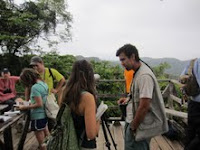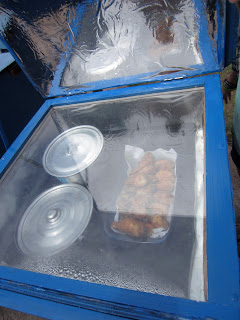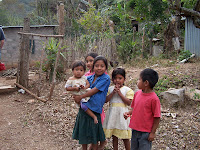Courtney in Copan, three months ago.
A shared vision, a common dream, similar work, recurring
values-these are all things that come to mind when someone says the word
“community”. Like sustainability (and like a lot of other things), I think
community is a word that’s used a lot but seldom practiced (well), at least in
my experience,
Sustainability conjures an image of windmills and solar
panels, of green spaces and flowers and happy farm animals-essentially all of
the stock photos on the covers of our books this semester. When someone says
sustainability, I think about it solely in terms of the environment and fixing
our environmental degradation/energy dependency.
As someone who has Sustainable Community Development as one
of their majors, I feel like I should have a better conception of what
sustainable communities are or should be. I guess I understand it at a
theoretical level, but I don’t think I had ever seen an example of a healthy,
functioning sustainable community before this trip.
The first and most important community experience for me on
this trip is the community we’ve built together. I’ve been in many different
group living situations before, but none with this much thought or
intentionality.
Looking back, the transformation about how I feel about
community has been a pretty significant experience for me on this trip. I’ve
never really felt this deeply embedded in a community, at least emotionally. I
guess in the past I felt like I was pretty community-oriented: I volunteer a lot and am involved in a
lot of local politics; I know my neighbors and go to a lot of community
functions. I know a lot of “important” people in the Ashland community and am
involved more than the average college student – I always assumed that this was
enough. I thought that by contributing to the common good and fulfilling my
civic duty and giving a lot I was doing my part to build a better community. I
wouldn’t say that I was entirely wrong, because I think a sense of service and
engagement in community is vital, but I completely discounted the emotional
side of community. I have never felt comfortable enough in a community to ask
for things. I have always assumed that feelings should be dealt with in the
private realm, meaning with your friends or family at home and that it was
pretty undesirable to be needy or to ask for things from your community.
I’ve come to the conclusion that the way we deal with our
emotions as a society is pretty shitty. Everyone has and is entitled to the
broad range of emotions that comes with being human, and everyone deserves an outlet for those emotions and to be supported in expressing those emotions. It
was both one of the most difficult and one of the most rewarding experiences
for me to be a part of building a community in which these things are allowed
and encouraged to happen. There were times that I didn’t feel comfortable
expressing myself and I’m sure others felt the same way, which means I have
some work to do both in terms of how I communicate to other people and how I
receive communication from others.
My family is pretty open to talking about how we feel, so I
don’t know where I got my reluctance/uncomfortability about talking about my
feelings or expressing needs-I guess it’s one of those cultural messages that’s
embedded so deeply that we don’t even notice it, but I think we’re all taught
from a very young age that it’s not okay to be needy and that we should usually
try to feel happy all the time. I really want to work on breaking down this
myth when I get home, but I don’t know how to do so without making people
uncomfortable. Activities like our check-ins, discussions, the Gifting Circle
and the Joanna Macy activity really helped me to feel comfortable with everyone
and allowed me to express myself in new ways, but we were all willing
participants in those activities, I feel like you can’t just bring a group of people
together and expect these things to work.
I guess my point is that truly sustainable communities have
to recognize people as whole people and provide spaces for people to grow and
develop and share and help others and be helped and communicated, otherwise
they won’t really be sustainable, they’ll just be more environmentally-sound
versions of what we were doing before.
I think that the community we’ve built here is sustainable,
even though we’ll all be leaving each other in a matter of days. I say its
sustainable because even though we’ll all be physically separated, how I feel
about everyone won’t change, and I’ll still continue to rely on and grow with
and share with all of the people on this trip, and to me that is the essence of
community.
Our community on our last day in Costa Rica.
In a lot of ways, some of the most significant learning for
me on this trip came from my peers, and Central America simply served as the
backdrop, which I guess just goes to show that usually what you’re looking for
can be found at home. However, did learn a lot of valuable things from the
places we visited and the people we met.
One of the first things that comes to mind is that
sustainability is hard. Not only does it take a lot of work to create and
synthesize and coalesce a community to be sustainable on a human level, to be
environmentally and ecologically sustainable requires a great understanding of
and relationship to the natural world, it also takes a tremendous amount of
physical work. Sustainability isn’t just something you come to know through your
head or your heart or your gut, you also feel it in your back and shoulders and
wrists; through having dirt on your palms and wind in your hair and sun in your
face; through the handle of a shovel and the bristles of a paintbrush. However
difficult the work may be, the rewards are endless.
Another thing I learned is that a little kindness goes a
long way. All of the small things I noticed that people do here, like greet
each other on the streets and stop by peoples’ houses when they pass and feeding whoever
comes by and watching each other’s kids did a lot to raise my spirits and give
me a sense of community wherever I went. The people here genuinely care about
each other and us and they didn’t have to do anything extravagant to make that
known. I want to remember this when I go home so that I can make more of an
effort to show kindness to the people I encounter. Every community has its
problems, but I didn’t see that stopping anyone here from caring about or
helping their neighbors, and I hope that’s a value I continue to carry with me.
I was also impressed by the relationship with nature most of
the people we encountered had. Most were so appreciative of the resources the
natural world provides, whereas I don’t think I’ve ever felt particularly
thankful when I turned on the faucet. Beyond the sense of gratitude most people
had for their resources, I also saw a great sense of wonder and appreciation
for the natural world simply because it existed. Remembering Pablo and
Mauricio’s excitement at every bird and every tree and Chico’s quiet patience
and love for his land and his work makes me want to live for fully with that
sense of connectedness and wonder. An individual or a community can’t function
always waiting for the next extraordinary moment – you’ll quickly become burnt out or disappointed
or jaded. But if you learn to love the ordinary because there is beauty in the
little things, and because each moment is different from the next and because
we share these ordinary moments with nature and each other, we can build from
that a better way of living.
So now when I think about “sustainability through
community”, I guess I have a better idea of what it is, though it’s still hard
for me to articulate. For me, sustainability through community is being in a place
where people care deeply about the natural world and each other, that creates a
space for people to grow and share and love, and that is a constant exchange of
giving and taking with no one keeping track. I don’t know all of what it takes
to build a sustainable community, but I want to try and I want to help create a
feeling of community in the places I am and the places I’m going. For me, the
idea of sustainability through community is reflected in the faces of Sebastian
and Chico and Aaron and Pablo and all of the wonderful people we’ve met on this
trip. I don’t think I’ll ever be able to fully communicate with anyone what I
learned or how I feel about sustainability through community, but hopefully I
can continue to live and learn it and show it to the places I’m going home to.
Courtney Remacle
Courtney Remacle



















